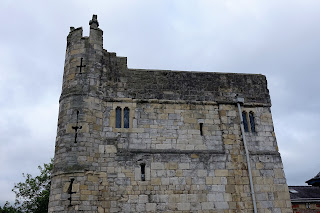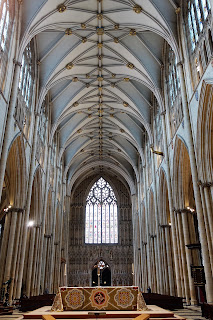Custard and the happy memories of childhood it conjures up
It was a long drive from Edinburgh to York, our final destination on our quick journey through parts of the United Kingdom. Once we got through the Scottish Borders, the weather eased up and traffic on the roads and motorways was relatively light on an ordinary Thursday afternoon (food options, however, were limited to Burger King at a service area). We pulled into York, dropped off our rented BMW at the Thrifty branch there, then caught a taxi to our last accommodations, the Brontë House on Grosvenor Terrace. It was yet another cozy, friendly B&B that reminded me of my grandmother's house. We were welcomed by the owners' adorable Burmese:
As usual, we set off exploring after checking in and dropping off our bags. York, with a history dating back to 71 CE when the Romans built a garrison there, is one of the most medieval cities in all of England, and the City Walls (which follow the line of the original Roman walls) provide a good introduction to that distant past. It takes 1½-2 hours to walk to entire 4.5 mile-circuit; we contented ourselves with the short stretch from Bootham Bar to Monk Bar and the fabulous views of York Minster cathedral:
We would wait until the following day to visit the Minster, but did take a look at the exterior after descending from the Walls. My wife was amused by the Chinese woman who couldn't stop taking photos of the cathedral and exclaiming how there was nothing like that back in her home country, much to the bemused consternation of her exasperated Yorkshire male companion:
Pub grub at the Lamb & Lion Inn. Yorkshire beef, of course:
In case I needed reminding of where we were:
The rear garden of the Bronte:
Breakfast, English-style, on Friday morning. The Yorkshire accent of the young woman seeing to the diners proved to be a significant hurdle for Shu-E - who would've thought a simple word like "toast" would prove to be a daunting challenge in comprehension for her:
First up that morning was York Minster, of course. It's the seat of the Archbishop of York, primate of England and second in importance only to the Archbishop of Canterbury. It's also the largest medieval cathedral in northern Europe. Lonely Planet describes it as "one of the world's most beautiful Gothic buildings." It's certainly a stunning sight.
The minster's origins date back to 627, when a wooden chapel was erected (on the site of a Roman basilica) for the baptism of King Edwin of Northumbria. It was later replaced with a stone church; the first Norman cathedral was put up in the 11th century. The building standing today was built between 1220 and 1480. The Rose Window is located in the south transept, symbolizing the union of the houses of Lancaster and York through the marriage of Henry VII to Elizabeth of York, ending the Wars of the Roses (goodbye Richard III; welcome Tudor dynasty):
Five Sisters Window, fifteen meters in height; most of the colored glass dates from 1250:
Inside the 13th-century chapter house:
Back in the main church:
This dragon's head was a crane used to lift a font cover:
The Great West Window (1338):
The high altar at the opposite end of the cathedral is dominated by the huge Great East Window (1405), with dimensions resembling those of a tennis court - 23.7 meters (77.8 feet) by 9.4 meters (30.1 feet). It's the largest medieval stained-glass window in the world, and depicts the beginning and end of the world as described in Genesis and the Book of Revelations. My camera doesn't do it justice; this website does a better job of it:
My Sony did a bit better with the views of York from the tower, reached after a climb of 275 steps:
From above to below, as we descended into the undercroft, treasury and crypt. The treasury contains a number of 11th-century artefacts, while the crypt has fragments from the Norman cathedral. You can also see the remains of the original Roman structure:
The Doomstone is a fascinating 12th-century carving depicting a scene from the Last Judgement in which demons cast the damned into Hell:
As my LP guide so aptly puts it, "if (York Minster) is the only cathedral you visit in England, you'll still walk away satisfied":
Having spent all morning in York Minster, it was time for a leisurely lunch break, in which I complemented my fish and chips with a side order of bubble and squeak:
As fantastic as the minster was, there's a lot more to see and do in York. We didn't have time to visit the highly-recommended National Railway Museum, but we were able to see the Jorvik Viking Centre, another worthwhile attraction. It's an interactive multimedia recreation of a 9th-century Viking settlement that was unearthed in the late 1970's. Visitors begin by taking a Disneylandish "time-car" through the town of Jorvik...:
...before looking at the various artefacts in the exhibition area. The "highlight" is the Lloyds Bank coprolite, a fossilized piece of human feces measuring an impressive 8 inches (20 centimeters) in length and 2 inches (5 centimeters) in width, and weighing an equally impressive half a pound. According to the sign, the owner of this Viking turd had to coexist with intestinal worms:
"This is the most exciting piece of excrement I've ever seen. In its own way, it's as valuable as the Crown Jewels"
Amber does some shopping at ...give the dog a bone:
The atmospheric Church of the Holy Trinity, which the caretaker kindly let us inside to have a look even though it was about to close for the day. The interior holds box pews dating from the 17th- and 18th centuries. When the Church of England was separated from the Catholic Church, these pews were set up in Anglican houses of worship to direct the focus of parishioners away from the altar; however, during the Victorian age, church interiors started to return back to the Catholic layout and box pews are now a rare sight:
The Shambles, one of the most picturesque (and visited) streets in the U.K. Taking its name from the Saxon word shamel (slaughterhouse), by 1862 there were 26 butcher shops located on the narrow cobbled lane. These days it makes for a good spot for an ice-cream break:
On our last evening in Albion, my wife was content to buy some snacks and beer from a local supermarket and retire to our room at the Bronte House. I wasn't, so I took my daughter out for dinner at Café Rouge:
Amber and I then partook of the Ghost Hunt of York, a very entertaining 75-minute tour of some of York's more haunted spots. Just make sure you aren't seen sporting an obviously touristy Union Jack umbrella as I was, or you may find yourself at the center of attention. I became "Big One" for the duration of the walk, much to my daughter's glee:
Many of the stories involved children, and were both sad and eerie. Behind this window, a little girl was abandoned by her parents and left to die in a sealed room when she developed plague symptoms; passersby were sympathetic, but wouldn't (or couldn't) do anything to help for fear of getting ill themselves:
All things must pass, as George Harrison once sang, and so on a Saturday morning we said goodbye to York and caught a train south to London's Kings Cross railway station:
From there, we took the tube one last time to Paddington Station. Michael Bond, Paddington Bear's creator, died while we were in York; the bronze statue at the station was covered with offerings left by mourners:
On the Heathrow Express to the airport, and eventually back to Vilnius:
In the two weeks that we were in England and Scotland, we had seen and done a lot, and yet it wasn't enough. Shu-E had trouble with the initial heat wave as well as the food, while for Amber, I'm sure she had a great time but it was probably just another in a long line of fun places she's been lucky to visit. This trip meant a lot to me, however, for many reasons. It was my first opportunity to see more of England than just London and Essex, as well as to get a taste of Scotland's charms. It was also a chance to reconnect with my ancestral roots, and to take a trip down memory lane, as my earliest recollections are of the time spent in my grandmother's home while my father was serving in Vietnam. Most of all it was a pilgrimage of sorts, a figurative scattering of my mother's ashes, so to speak - she'd passed away a couple of months before our trip, and it was through her that I'd always maintained an emotional connection to Britain, even when my interests started to drift towards East Asia during my final year at college.
It hasn't been an easy year for the United Kingdom, but throughout our trip I never had the impression the country was under siege or that its people were somehow reeling from everything that had happened. There will always be an England (and a Scotland), and I plan on returning one day (though I intend on seeing some of Ireland, the other ancestral homeland, first). Vera Lynn would be the obvious musical selection with which to end this blog post, but instead I'll leave you with the song that was most playing in my head as we journeyed through some wonderful parts of the British Isles:









































































No comments:
Post a Comment